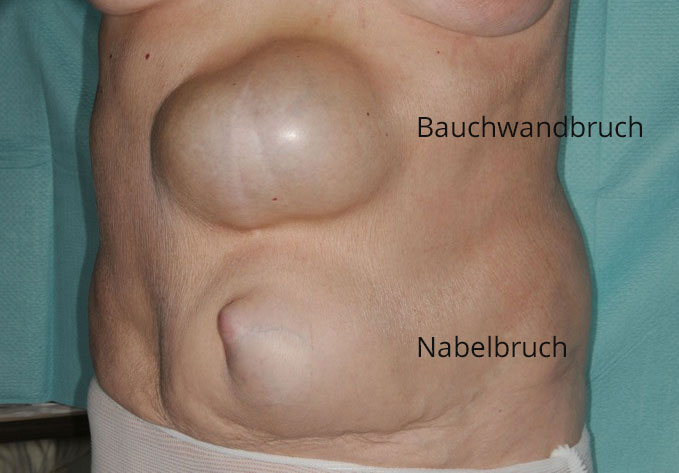Umbilical and abdominal wall hernia
Umbilical hernia
An umbilical hernia occurs at the navel due to a gap in the tendinous layer of the abdominal wall; a segment of the intestine will emerge through this opening in the standing position, or upon coughing or pressing. Here, the tendinous layer of the abdominal wall is absent and the small opening is filled with scar tissue. The navel is basically a weak point. After birth the blood vessels embedded in the umbilical cord atrophy, giving the navel its typical appearance. Intense physical exertion can lead to a tear in this delicate tissue and a hernia. Women quite often develop an umbilical hernia during pregnancy, so that the incidence of this disorder is greater in women.
The diagnosis is usually simple: with gentle pressure, the protrusion can be pushed back into the abdominal cavity, and in the recumbent position, the hernia disappears of its own accord. If there is any uncertainty about the diagnosis, ultrasound will clarify the situation. If the protrusion is painful and cannot be pushed back into the abdomen, it may be pinched off (incarcerated), in which case immediate surgery is necessary.
Because any hernia can become incarcerated, the best treatment option is surgery. Small hernias can be closed with simple sutures. If a hernia is larger, or the tissue very thin, a nonresorbable mesh should be applied to reinforce the closure.
The operation can be performed conventionally or laparoscopically. Laparoscopy is preferred for hernias larger than 4-5 cm, for seriously overweight patients, or for re-operation after previous hernia surgery. The duration of surgery depends on the size of the hernia and the extent of adhesions. The patient can usually be discharged after only a few days.
Abdominal wall hernia
Due to individual circumstances or external influences, there can be weak points in the abdominal wall that can herniate, with a protrusion that is noticeable in the standing position or upon coughing, sneezing and pressing. The protrusion can be pressed gently back into place, or disappears of its own accord upon lying down. Because of these typical features, the diagnosis is not difficult, but in obese persons, the hernia may not even be noticed until it becomes painful. If there is any uncertainty, ultrasonography will secure the diagnosis.
Due to the danger of incarceration, abdominal wall hernias should always be treated surgically, preferably without delay since the hernia will increase in size with time and the operation will be longer and more complicated. Sudden, increasing pain usually signals incarceration of protruding abdominal organs and requires emergency surgery.
An abdominal wall hernia larger than 4-5 cm should be operated laparoscopically, with application of a nonresorbable synthetic mesh. Conventional technique is fine for smaller hernias, whereby the consistency of the tissue will determine whether a synthetic mesh is also necessary. Hospitalization generally varies between one and five days. With larger hernias an abdominal corset may be recommended.

